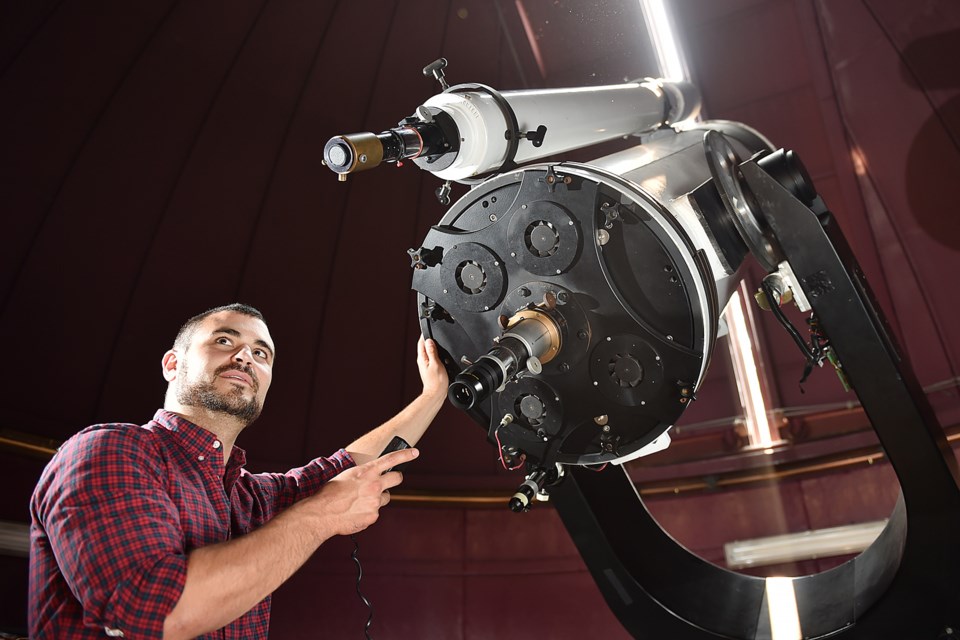It’s tempting to ask Derek Kief whether he can predict clear skies for the morning of the solar eclipse.
But Kief is an astronomer, not an astrologer. Using the stars to tell us our future isn’t his bailiwick. Using his knowledge about the stars — including our sun — to reveal the incredible universe around us is.
Still, as one of the people preparing to welcome hundreds of people to the H.R. MacMillan Space Centre on Aug. 21, he has a vested interest in the weather that morning.
“You can never predict 100 per cent, but the current long-term forecast is it should be good,” says Kief, one of the space centre’s two resident astronomers.
From 9:10 to 11:37 a.m. on Aug. 21, the moon’s orbit will block our view of the sun. Skies will darken, temperatures will cool. And thousands of people will look up, way up, as the moon slowly slips into and past the space occupied by the sun.
“The viewing will be spectacular. It’s an opportunity to revel in the marvels all around us,” Kief says.
“Eclipses happen all the time,” he adds. “In the next 100 years there will be 69 eclipses. It’s just a question of where they are. Most of the time they’re over water because most of the planet is water. To have it go over the mainland for so long and have everyone be able to see it, that’s the rarity and really exciting part. The moon is just doing its thing.”
The first thing Kief wants us to know is we should never look directly at the sun. You will do permanent damage to your eyes.
“Sunglasses are a big no-no, too,” he says. “They are never a good enough option.”
While people directly under the path of what’s being called the Great American Total Solar Eclipse will be able to look directly at the sun for roughly two minutes when it’s blocked entirely by the new moon, here in Vancouver we’ll be experiencing the eclipse in 86 per cent totality.
That 14 per cent of direct sunlight seeping out from the edge of the moon is still strong enough to hurt our eyes.
“You won’t realize your eyes are being damaged,” he says of those tempted to look.
The space centre is handing out ISO-approved solar glasses which will block out all light except for the sun. Put them on indoors, or even outdoors, and everything will appear black. The only thing they let you see is the sun.
“If you do it safely, [looking at the sun] is safe to do,” says Kief.
And don’t expect to be able to take a selfie with the eclipse as a backdrop. Our eyes might be too sensitive for the sun’s rays, but a camera phone or camera isn’t sensitive enough to do the trick, Kief says. Photographers who want to capture the “wow” moment are advised to go to a camera shop or online to ask about solar scopes and filters.
“Do your research and get someone to check your equipment before you do it,” he says, also cautioning people not to think that looking at the eclipse through a camera lens is enough to protect the eyes.
However, that doesn’t mean you can’t get a photo of yourself during the eclipse.
The space centre will have four different telescopes in operation. One is a projection scope that will project the eclipse onto a 1.5-metre-wide screen that you can pose in front of.
The most fascinating moments are those just before and after the total eclipse. One effect is called the diamond ring, where the sun creates a glow around the moon and there’s a dazzling burst of light. Another is Baily’s Beads. “The moon is not a perfect circle,” Kief says. “It has craters and the craters start to become apparent in the eclipse. Some of the sunlight will come through the craters on the edge of the moon. It’s the last thing you see before totality and the first thing after.”
As part of its morning celebration, the space centre is setting up craft centres and activities for children. One of the things they can make is their own pinhole projector.
Admission to the outdoor eclipse party is by donation and includes solar glasses, which can also be obtained in advance, by donation, at the space centre in Vanier Park, right on the south side of English Bay near Bard on the Beach’s tents.
Everyone is invited to stay afterwards to enjoy the space centre’s other exhibits and shows, including Solar Superstorms, narrated by Benedict Cumberbatch. The 45-minute show reveals the full fury of the sun’s energy, including high-velocity jets, a fiery tsunami wave that reaches 100,000 kilometres high and rising loops of electrified gas. It’s for ages six and older.
In the meantime, on Aug. 17, the space centre is collaborating with Curiosity Collider for Eclipse: Total Alignment, an exploration of the eclipse’s momentary darkness through art and science. There will be performances and stories under the planetarium theatre dome and installation art in the Cosmic Courtyard exhibit. Artists and scientists will be on hand to discuss this one-night-only presentation. It’s a licensed event for those 19 and older only and you have the choice of a 7:30 and 9:30 p.m. presentation. Tickets are $25 to $30 and are available on eventbrite.com.



